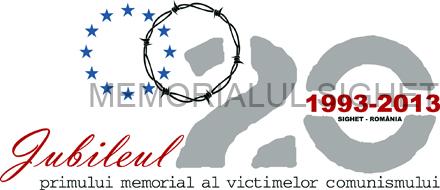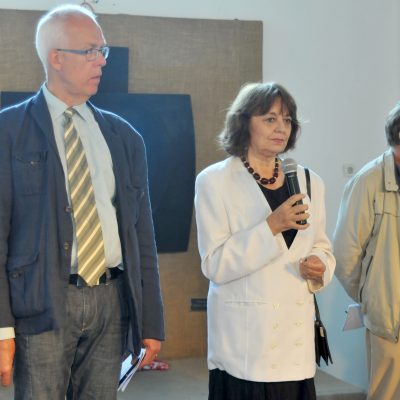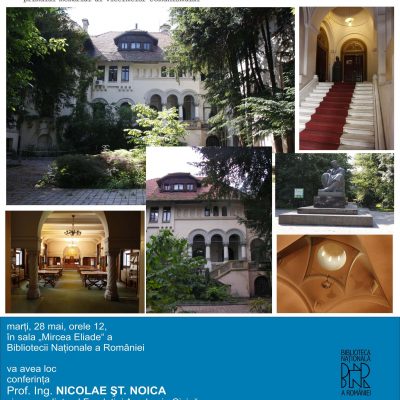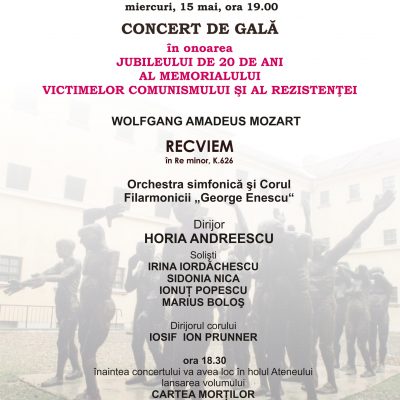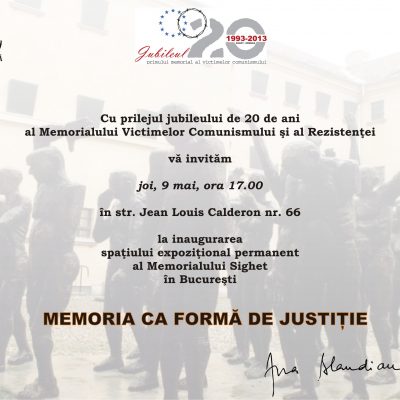• Ana Blandiana’s participation in the international conference on human rights held by the Council of Europe in Strasbourg two decades ago
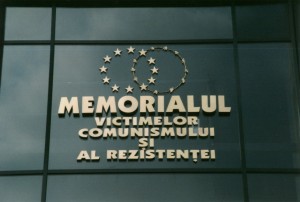
• The proposal at that time for a memorial to be created in a former political prison in Romania
• The visit to Sighet in 1994 and 1995 of two commissions from Strasbourg and their reports approving the placement of the future memorial under the aegis of the Council of Europe.
• 9 May: opening of the “Memory as a Form of Justice” exhibition space, the permanent branch of the Sighet Memorial in Bucharest, at no. 66, Jean-Louis Calderon Street.
Created by designers Ștefan Popa and Octavian Carabela, the Memorial’s “embassy” in the capital debunks a myth spread by the press for many years, according to which Romania “does not have a museum of communism”, while at the same time pirating emblematic images from Sighet – “The Convoy of the Sacrificial Victims”, for example—without ever mentioning where they are to be found.
• 15 May: gala performance of Mozart’s Requiem at the Romanian Athenaeum The gala concert was performed by the Georges Enesco Philharmonic Orchestra conducted by Horia Andreescu in front of a packed auditorium. The audience, which included leading intellectual figures, were there to commemorate the inter-war elite that perished in Sighet Prison. In the lobby of the Romanian Athenaeum a ceremony to open an exhibition about the world’s first Memorial to the Victims of Communism was held, and in official box in the auditorium were seated former political prisoners. A significant part of the diplomatic corps was also present.
• 13 June: Day of Memory, traditional at Sighet
• 15 July: jubilee edition of the Sighet Summer School
• 16 July: ceremonial session at the Representative Office of the European Commission in Bucharest.
The internationally attended meetings in Sighet and Bucharest held between 12 and 16 July brought together a large number of leading historians, who had lectured at Sighet over the previous twenty years, as well as pupils who had attended the Summer School over the sixteen years of its existence. The speakers were: Stéphane Courtois,
Alexandru Zub, Dennis Deletant, José María Ballester, Göran Lindblad, Șerban Papacostea, Pierre Hassner, Thomas Blanton, Thierry Wolton, Dragoș Petrescu, Cristina Petrescu, Virgiliu Țârău, Anatol Petrencu, Ion Pop, Romulus Rusan, Anneli Ute Gabanyi, Günther Czernetzky, Octav Bjoza, Mircea Carp, Roman Wyborski,
Micaela Ghițescu, Ioana Raluca Voicu-Arnăuțoiu, Petruška Šuštrová, Patrick Moreau, Teodor Stanca, Andrei Oișteanu, Libuše Valentová, Dan C. Mihăilescu, Cristian Vasile, Radu F. Alexandru, Elena Siupiur, Liviu Țîrău, Miodrag Milin, Rita Schorpp, Traian Orban, His Excellency Niculae Idu, the head of the Representative Office of the European Commission in Bucharest, and Ana Blandiana (chair person). Likewise, a number of former pupils gave speeches, as did Mr Sven-Joachim Irmer, the director of the representative office of the Konrad Adenauer Foundation, which sponsored the summer schools.
The meeting held on 16 July at the European Public Space in Bucharest closed with the launch of an anniversary medallion struck in honour of the jubilee.
In parallel, a series of books were published or re-published. Under the aegis of the Centre for Studies of Communism were published the fourth edition of Dennis Deletant’s Romania Under the Communist Regime, the third edition of Florin Constantin Pavlovici’s memoir Torture Made Simple to All, and the second edition, after sixteen years, of Thomas S. Blanton’s What President Truman Knew about Romania. Other publications included Vasile Gh. Baghiu’s Prisoner in the USSR; a translation from the German of Hans Bergel’s book about his brother: A Musician’s
Life: Erich Bergel; Saints I Met (Nistor Man interviewed by Traian Călin Uba); Valentin Hossu-Longin’s The Canal of Death: Witness; and the collection Childhood as Class Struggle, to which all the foundation’s researchers contributed and which also contains the testimonies of children whose parents were imprisoned under communism, some of them dying in prison. The volume Alexandru Zub at Sighet is a fresco of ideas and impressions, as well as a
systematic, academically structured transcription of the great historian’s attendance at the Memorial and his contributions to its activities. From France, via Stéphane Courtois, Reynald Secher’s Vandeea: From Genocide
to Memoricide was published in translation, a study of how Robespierre’s Terror prefigured the political mass killings of the next two centuries.
And finally, after five years of research, The Book of the Dead was published, a massive 880-page dictionary of those who perished during the bloody history of six decades of the last century: prisoners, deportees, those who died in the labour camps, in peasant uprisings and in the partisan movements, people who did not live to be able to look back on their past through the lens of freedom (edited with an introduction by Romulus Rusan; contributors: Ioana Boca, Virginia Ion, Angela Bilcea, Andreea Cârstea).
A remarkable book by Katharina Kilzer and Helmut Müller-Enbergs, published in German by Frank & Timme, Geist hinter Gittern: Die rumänische Gedenkstätte Memorial Sighet is a gift to the Sighet Memorial from its friends abroad: from France, Germany, the United States, Russia, and of course Romania. The book was meanwhile published in Romanian translation.
Reviews: Banater Schwaben (Walter Tonța), revista Cultura (George Neagoe), Revista 22 – Bucureștiul Cultural (Nicolae Prelipceanu), LaPunkt (Cristian Vasile), revista Ramuri (Adrian Popescu), Revista 22 (Armand Goșu, Olivia Spiridon), Allgemeine Deutsche Zeitung (Jürgen Henkel), revista Mesagerul Sfântului Anton (Adrian Popescu), revista Convorbiri Literare (Vasile Iancu), revista Acolada (Nicolae Prelipceanu), Mișcarea Literară (Victor Știr, Olimpiu Nușfelean, Virgil Rațiu, Ion Radu Zăgreanu, Ioan Sabin Mureșan, Simona Simioanca Retegan), Banater Post (Halrun Reinholz), revista Polis (Dan Pavel), România Literară (Sorin Lavric), Viața Românească (Gabriel Pleșea), revista Dacia Literară (Vasile Iancu).
On the occasion of the Summer School at the Sighet Memorial the “Memory of Manuscripts” room was inaugurated on the second floor of the museum, comprising manuscripts of literary masterpieces of prison literature: NicolaeSteinhardt’s Diary of Happiness, Dinu Pillat’s Waiting for the Final Hour, Remus Radina’s Morgue Testament, Florin Constantin Pavlovici’s Torture Made Simple to All, Aurel State’s The Road of the Cross, Ioan Marta’s The History of the National Peasants’ Party, and letters written from prison by Gheorghe I. Brătianu, Silviu Dragomir, Corneliu Coposu, and Cicerone Ionițoiu and sent by Mircea Carp in exile.The series of events also included lectures by academician Professor Alexandru Zub (“The Sighet Memorial: An Institution for Romania”, 7 March, the National Library of Romania), engineer Professor Nicolae Șt. Noica (“The Brătianus and the Founders of Modern Romania, 28 May, the National Library of Romania), and Ana Blandiana (“National Values in the European Context”, 27 June, the Representative Office of the European Commission in Bucharest).The “Black Whitsun” exhibition continued to tour Germany: Munich (25 January), Augsburg (25 April), Tubingen (19 June), garnering numerous mentions in the German press: Siebenbuerger Zeitung, Banater Post, Schwäbische Tagblatt.
The exhibition titled The Canal: A Programmed Cemetery was shown in Bucharest at the Dialog room of Sector 2 Town Hall (28 March) and then at the Pantelimon 61 district Complex for Recreation and Education.
In September the Memory as a Form of Justice exhibition, dedicated to the twentieth jubilee of the Sighet Memorial, was shown at the Göteborg International Book Fair, where Romulus Rusan gave a lecture about the history of the Memorial to the Victims of Communism and to the Resistance.
In parallel, two temporary exhibitions opened at the permanent exhibition space at no. 66, Calderon Street in Bucharest: Recsk: The Hungarian Gulag (an exhibition of the Historical Archive of the Secret Services, Budapest, which opened on 20 May) and The 1987 Brașov Uprisings (an exhibition of the National Council for the Study of the Securitate Archives, which opened on 17 June).
In October, at the invitation of the Historical Archive of the Secret Services, Budapest, the Danube-Black Sea Canal: A Programmed Cemetery exhibition of the International Centre for Studies of Communism opened in Budapest at the Recsk Memorial and the Black Whitsun: The Bărăgan Deportations exhibition at the Jacobins Room of the Hungarian Academy in Budapest. The exhibitions were presented by Ioana Boca and Virginia Ion.
All the stages of this celebration of the Sighet Memorial made an extraordinary impression in the press: articles in Revista 22 (Alexandru Gussi, Elena Siupiur, Smaranda Vultur), Adevărul (Laurențiu Ungureanu, Anca Vancu, Cristina Hermeziu), Dilema Veche (Andrei Pleșu, Matei Martin), România Literară (Sorin Lavric), Observatorul Cultural (Doina Ioanid, Romulus Rusan), Observatorul Militar (Florin Șperlea), Evenimentul zilei (Vladimir Tismăneanu), revista Memoria, revista LaPunkt (Cristian Vasile), Dacia Literară (Alexandru Zub), revista Cultura (Ștefan Baghiu), Graiul Maramureșului (Florentin Năsui), Allgemeine Deutsche Zeitung (Aida Ivan), Convorbiri Literare (Alexandru Zub), Siebenbürgische Zeitung (Katharina Kilzer), features on Radio România Cultural, România Actualități and România Internațional, in programmes on Revista literară radio (Teodora Stanciu), Pagini de Istorie (Dan Manolache), Timpul prezent (Adela Greceanu și Matei Martin), Etică, estetică (Teodora Stanciu), Teme deschise (Marina Dumitrescu-Baconschi), Magazin de vorbe (Simona Popescu), Români în lume (Denise Theodoru), on RFI (Ioana Hașu), on Radio Europa Liberă (Lucian Ștefănescu), films on TVR 1 (presented by Filaret Acatrinei and Radu Găină, 9 June; and by Gabriel Geamănu, on 13 iunie).
To these can also be added reports from various events featured in news bulletins broadcast by TVR, B1TV, Digi24, DunaTV. On the occasion of the jubilee, Ana Blandiana was interviewed on Trinitas TV by Vasile Bănescu (“Demnitate și onestitate”, 6 July), on Digi 24 by Luca Niculescu (“Imparțial”, 25 July), on Nașul TV by Grigore Cartianu (“Cronica de noapte”, 13 May), by Nicoleta Savin (“Ora de veghe”, 18 July) and Vartan Arachelian (“Cuvîntul 62 care zidește” – 25 July), on B1TV by Mădălina Pușcalău (“Talk B1”, 23 May), on TVR2 (“România frumoasă”, 16 May). Interviews on the subject were also conducted by Andrei Crăciun in Adevărul (4 March), by Sorin Lavric in România Literară (10 May), by Ion Dumitru on Radio România Actualități, and by Ioana Hașu on RFI (10 May). The most wide-ranging report was broadcast live from Sighet by France Presse, producer: Isabelle Wesselingh (“From the Depths of a Communist Prison: An Ode to Freedom and Resistance”), which was syndicated to more than thirty publications in Europe, America, Asia and Africa.
An extensive, five-episode documentary was dedicated to the Sighet Memorial as part of the prestigious Memorial to Pain series produced by Lucia Hossu-Longin.
All the above confirmed once and for all the prestige of the world’s first Memorial to the Victims of Communism, created in Romania twenty years ago.
The jubilee closed symbolically at the House of Europe in Paris, led by Catherine Lalumiére, where on 4 December a colloquium with the title “Twenty Years of Memory, a Quarter of a Century of Transition: Towards What?” was held in partnership with the Association pour le Mémorial Sighet and the Romanian House.


